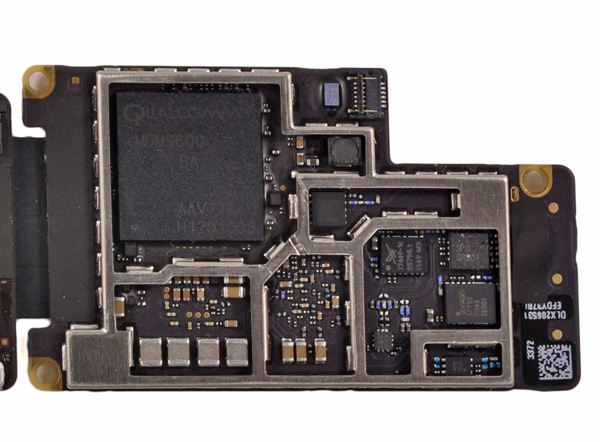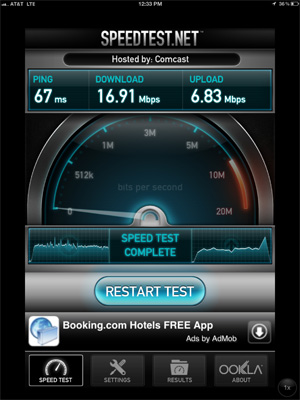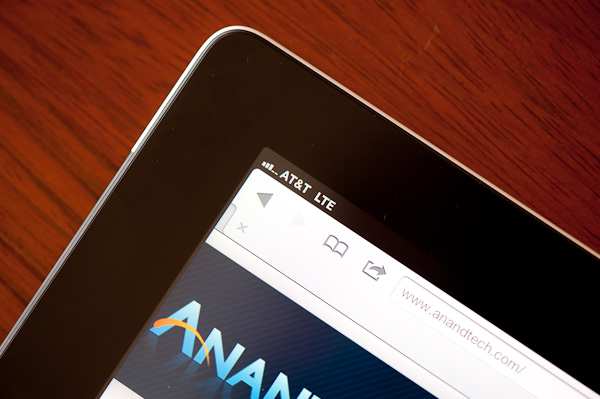The Apple iPad Review (2012)
by Vivek Gowri & Anand Lal Shimpi on March 28, 2012 3:14 PM ESTThe Most Tangible Feature: LTE Support
As the iPad straddles the divide between the smartphone and the notebook, wireless connectivity is a must to maximize its usefulness. In cities where WiFi is plentiful, opting for cellular connectivity isn't absolutely necessary, but in most of my travels I find that having some form of data plan associated with your tablet makes it a far more useful device.
If you already have a wireless hotspot or can create one through your smartphone, the appeal of a cellular modem in your iPad is diminished. There's still the convenience aspect of simply unlocking your tablet and having internet access regardless of where you are, and without having to turn on another device or configure a software based personal hotspot.
If you don't have either of these things however, and you plan on using your iPad regularly outside of your home/office, buying one of the cellular enabled versions is a costly but sensible decision.
In the past the iPad was limited to 3G operation, however arguably one of the most tangible improvements with the new iPad is its support for LTE. Through Qualcomm's MDM9600, a 45nm LTE modem with support for EVDO and HSPA+ (but no voice), Apple brings the most complete set of cellular connectivity options we've seen on the iPad.

Qualcomm's MDM9600 in the LTE iPad, courtesy iFixit
Before we get to the discussion of service plans, performance and the personal hotspot, I must stress just how big of an improvement LTE is on the iPad compared to last year's 3G models. Although LTE on a smartphone is pretty amazing, it's even more shocking on a tablet. Assuming your usage model on an iPad is a closer approximation of a notebook usage model, the inclusion of LTE is akin to always being on an extremely fast cable internet connection. Web pages load up just as quickly over LTE as they do over WiFi at my home (since the iPad's WiFi is limited to around 30Mbps in most cases, which ends up being peak downstream for me on AT&T's LTE network here in Raleigh). At my parents' house, where the fastest internet available is 6Mbps DSL, it's actually even faster for me to browse the web on the LTE iPad than it is using their WiFi. Obviously their home internet offers unlimited data transfers, while the LTE iPad does not, but for non-primary use the performance is absolutely worth the entry fee.

I mentioned the LTE connectivity on the new iPad is the most tangible feature of the tablet because the improvement in web page loading times alone makes the tablet feel much faster than its predecessor. While you can argue about how significant the Retina Display is, there's no debating about how much faster LTE is over the 3G iPad 2 models when out of range of WiFi. It's just awesome.
The LTE Breakdown, Carrier/Frequency Support
In the US, Apple makes three versions of the new iPad available: a WiFi-only device that lacks the MDM9600 and its associated components, a Verizon LTE version and an AT&T LTE version. The pricing between the three options is outlined below:
| The new iPad Lineup | |||||
| 16GB | 32GB | 64GB | |||
| WiFi | $499 | $599 | $699 | ||
| AT&T WiFi + 4G | $629 | $729 | $829 | ||
| Verizon WiFi + 4G | $629 | $729 | $829 | ||
As has always been the case, these's a $130 adder to enable cellular connectivity on the iPad. Apple is making up for slimmer than usual margins on the 16GB WiFi iPads by charging quite a bit for NAND and cellular upgrades. Unfortunately there's no way around the cost (outside of relying on an external hotspot via smartphone/MiFi) and the added functionality is definitely worth it.
Just as before, AT&T and Verizon offer no-contract data plans for use with the new iPad. These plans don't require any activation fee and can be managed on the iPad itself. You can cancel and re-activate at any time:
| iPad Data Plans | ||||||
| $14.99 | $20 | $30 | $50 | |||
| AT&T | 250MB | - | 3GB | 5GB | ||
| Verizon | - | 1GB | 2GB | 5GB | ||
AT&T offers the better "deal" at $30 per month although both carriers offer the same 5GB limit for $50 per month. Currently only Verizon enables iOS' personal hotspot option on all of its plans for no additional charge. AT&T claims it is working on enabling personal hotspot, however it is currently not available.
Both the AT&T and Verizon versions support the same GSM/UMTS/HSPA/HSPA+ frequencies and ship carrier unlocked so you can swap in any microSIM and use your iPad on a supported network. The table of bands supported by both models is below:
| Cellular Network Support | ||||
| AT&T WiFi + 4G | Verizon WiFi + 4G | |||
| 4G LTE | 700 MHz, AWS | 700MHz | ||
| EV-DO Rev. A | - | 800, 1900 MHz | ||
| UMTS/HSPA/HSPA+/DC-HSDPA | 850, 900, 1900, 2100 MHz | |||
| GSM/EDGE | 850, 900, 1800, 1900 MHz | |||
The premise behind shipping the iPad unlocked is to allow users to purchase and use SIM cards from around the world when traveling. As long as the network you're on is supported by the iPad, your microSIM will work.
LTE support is unfortunately confined to North America only. International support is limited to 3G. And although DC-HSPA+ is supported by the new iPad, T-Mobile customers in the US are mostly out of luck. A T-Mobile microSIM will work but unless you're in a market where T-Mobile has enabled W-CDMA on 1900MHz, you'll be limited to EDGE speeds. In theory, if T-Mobile had two available W-CDMA carriers on 1900MHz in your area you could get DC-HSPA+ but that seems highly unlikely given the limited 1900MHz spectrum T-Mobile has available.
Although both AT&T and Verizon have LTE-FDD deployed on 10MHz wide carriers in the US, many AT&T markets use 5MHz carriers. In a 5MHz AT&T LTE-FDD market, assuming all else is equal in terms of deployment and loading, Verizon's network should be significantly faster. The reality of the matter is far more complex. Verizon's LTE network is (presumably) far more utilized as its been in operation for longer than AT&T's. Verizon's carrier bandwidth advantages can easily be eaten up by an increase in active LTE subscribers. On the flip side, there's also the question of deployment strategies. Take Las Vegas for example. As we found at CES, AT&T had great coverage in key areas (e.g. the Las Vegas Convention Center), however at other hotels around the Las Vegas Strip we typically had better luck on Verizon. It's been my personal experience that AT&T's network is either be great or horrible, with very little in between. Verizon on the other hand tends to deploy much more evenly from what I've seen.
Raleigh, NC, my home town, happens to be a 5MHz market for AT&T. With both AT&T and Verizon LTE deployed here, I ran through a combination of nearly 200 speedtests across two LTE iPads around the North Raleigh area:
_AT&T4GLTE_Downstream.png)
_Verizon4GLTE_Downstream.png)
| AT&T LTE vs. Verizon LTE in Raleigh, NC—Downstream | |||||
| Average | Max | Min | |||
| AT&T | 11.46 Mbps | 25.85 Mbps | 1.12 Mbps | ||
| Verizon | 13.33 Mbps | 29.52 Mbps | 0.33 Mbps | ||
_AT&T4GLTE_Upstream.png)
_Verizon4GLTE_Upstream.png)
| AT&T LTE vs. Verizon LTE in Raleigh, NC—Upstream | |||||
| Average | Max | Min | |||
| AT&T | 4.44 Mbps | 12.35 Mbps | 0.07 Mbps | ||
| Verizon | 4.52 Mbps | 19.67 Mbps | 0.01 Mbps | ||
_AT&T4GLTE_Latency.png)
_Verizon4GLTE_Latency.png)
| AT&T LTE vs. Verizon LTE in Raleigh, NC—Latency | |||||
| Average | Max | Min | |||
| AT&T | 72.9 ms | 120.0 ms | 58.0 ms | ||
| Verizon | 84.1 ms | 217.0 ms | 60.0 ms | ||
On average, Verizon was faster than AT&T. I measured a 15% advantage in average downstream speed and a similar improvement in latency. The two were roughly equivalent in average upload speeds, with AT&T managing a small 1.8% advantage. The numbers were closer than expected, given that Raleigh is a 5MHz market for AT&T, but I suspect some of the mitigating factors I mentioned above are at work here.
Subjectively, Verizon did seem to be faster more often although I didn't really have any complaints about the performance of the AT&T LTE iPad. Both iPads indicated they remained on LTE although, as you can see from the data above, performance can get very low before officially falling back to 3G.
In the case of the AT&T iPad, if you don't have LTE coverage you first fall back to HSPA+ which can still deliver respectable performance. Verizon iPad owners will unfortunately fall back to EVDO, which can be significantly slower. If Verizon LTE coverage is good in the places you plan on using your iPad then this difference isn't really a big deal. As with any smartphone carrier decision, you need to factor in where you plan on using the device into your decision.











234 Comments
View All Comments
kwamayze - Friday, March 30, 2012 - link
WOW!!! What a nice review!!! Well donemichalkaznowski - Saturday, March 31, 2012 - link
Just to say as always a brilliant view. Your site is a must view for any enthusiast here in the UK. I also have appreciated your wireless router reviews of the Airport Extreme Base Station. Only you have pointed out that it has a quantum leap stability when compared to other makes of routers, something that a group of us have had to find out a very hard, frustrating and long way!Michal
x0rg - Saturday, March 31, 2012 - link
I have a suggestion. Instead of taking pictures you could take screenshots of these devices when you show how beautiful the screen is while working with Remote Desktop. Pictures taken with the camera look terrible and the whole concept of taking pictures instead of screenshots seems unprofessional for the portal like AnandTech. Things like focus, gamma, apperture are not affecting the picture quality when you just take a screenshot (Home+Power on iPad, you know that). Please replace these terrible pictures with screenshots. Thank you.slashbinslashbash - Sunday, April 1, 2012 - link
You missed the whole point of that part of the review. The point of the photos was to show that the text over Remote Desktop is actually readable in real-world use. A screenshot wouldn't convey that information.Imagine this. Say you took an iPhone 4 screenshot of the same scene in Remote Desktop, and you posted it on the site. This would be a 640x960 pixel image. Text would be readable on a desktop monitor, but it would probably not be readable on the actual 3.5" iPhone screen. That is the question, and it applies equally to the iPad3 review. A screenshot just shows you what pixels the iPad is showing; a photo shows you how those pixels look in real-life.
x0rg - Thursday, April 5, 2012 - link
I agree, my bad.TekFanChris - Sunday, April 1, 2012 - link
Thank you Anand and Vivek! You guys always take the iPad reviews to the next level. Comprehensive and complete.Cheers.
Death666Angel - Monday, April 2, 2012 - link
That kinda reminded me of the PS2 vs PC quality back in the days. :Djosemonmaliakal - Monday, April 2, 2012 - link
Hi Your article seems be so good . And i have got something about the upcoming iPhone 5 of Apple here @ http://wp.me/p2gN9B-lqWardawg - Thursday, April 5, 2012 - link
You forget the new iPad just came out 95% of the apps have not upgraded for the new retina display yet. So all of these comparisons are very inaccurate. It doesn't matter that the iPad has higher res and 3.1 million pixels if the app isn't upgraded for retina display it won't display as such you would expect. I expect you guys to make a new article soon fixing these concerns of mine with this article.Noobuser45 - Monday, April 9, 2012 - link
Anand, you're the only tech expert that I trust so I would love to have my mind put at ease with a definitive answer from you. Is it fine to charge the iPad whenever you want? Can I charge without running it down first? Can I charge for a while and unplug it before it has reached a full charge? Can I use it while it's charging? I just don't want to screw up the battery life.